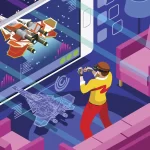AI for Autonomous Drones: AI-driven decision-making in autonomous drone operations.
In the dynamic landscape of technological advancements, autonomous drones have emerged as a powerful tool across various industries. From aerial photography to package delivery and environmental monitoring, the applications of drones are vast and continually expanding. However, the successful integration of autonomous drones into these domains hinges on the capability of Artificial Intelligence (AI) to make informed and precise decisions in real-time. In this blog, we will delve into the realm of AI-driven decision-making in autonomous drone operations and explore how it is transforming industries.
The Role of AI in Autonomous Drones
Autonomous drones are essentially unmanned aerial vehicles (UAVs) that can perform tasks without human intervention. What sets these drones apart is their ability to adapt and react to complex environments using AI algorithms. AI equips these drones with the power to perceive their surroundings, process information, and make decisions based on data collected from sensors and cameras.
Perception and Sensing
AI algorithms empower drones to perceive their environment through sensors such as LiDAR (Light Detection and Ranging), cameras, GPS, and IMUs (Inertial Measurement Units). These sensors capture real-time data, which AI interprets to create a comprehensive understanding of the drone’s surroundings. This allows drones to navigate around obstacles, detect changes in the environment, and maintain their position accurately.
Decision-Making Capabilities
The crux of AI-driven autonomous drones lies in their decision-making abilities. These drones are equipped with sophisticated algorithms that analyze the collected data and generate decisions in real-time. For example, in search and rescue missions, drones can use AI to identify survivors in disaster-stricken areas and calculate the most efficient route for intervention.
Path Planning and Collision Avoidance
Path planning is a crucial aspect of autonomous drone operations. AI algorithms aid in determining the optimal flight path by considering factors such as distance, obstacles, weather conditions, and air traffic. Collision avoidance algorithms ensure that drones can reroute if they encounter unexpected obstacles during their flight. This capability not only enhances the safety of operations but also minimizes the risk of accidents.
Challenges and Ethical Considerations
Despite the remarkable advancements in AI-driven autonomous drones, there are challenges that need to be addressed. Ensuring the safety of manned aircraft, addressing privacy concerns related to data collection, and maintaining reliable communication in remote areas are among the challenges that require thoughtful solutions.
Moreover, ethical considerations play a significant role. The potential for misuse of autonomous drones, such as invading privacy or weaponization, demands robust regulations and responsible deployment of this technology.
Industry Transformations
The integration of AI into autonomous drone operations is transforming various industries:
- Agriculture: Drones equipped with AI can monitor crops, assess soil health, and optimize irrigation, leading to improved yields and resource efficiency.
- Infrastructure Inspection: Drones can inspect critical infrastructure such as bridges, power lines, and pipelines, identifying maintenance needs and minimizing human risk.
- Emergency Response: AI-enabled drones can rapidly assess disaster-affected areas, providing vital information to first responders for efficient rescue operations.
- Delivery Services: Companies are exploring drone delivery options, leveraging AI to navigate through urban environments and deliver packages swiftly.
- Environmental Monitoring: Drones equipped with AI can monitor wildlife, track deforestation, and assess pollution levels, contributing to conservation efforts.


































